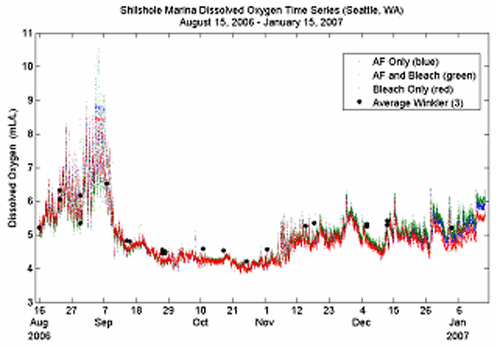 WET Labs
WET Labs
Water Quality Monitor (WQM)
 WET Labs
WET Labs
![]()
 New
Water Quality Monitor (WQM) provides the “Top 5” marine water quality parameters
in one package (temperature, salinity, dissolved oxygen, chlorophyll
fluorescence, and turbidity). The WQM’s sensors have the accuracy and
precision to track subtle long-term changes in clean ocean environments.
Multiple active and passive anti-fouling features effectively inhibit
fouling, even in biologically rich coastal waters. The WQM has been extensively
field-tested and demonstrated unprecedented long-term stability.
New
Water Quality Monitor (WQM) provides the “Top 5” marine water quality parameters
in one package (temperature, salinity, dissolved oxygen, chlorophyll
fluorescence, and turbidity). The WQM’s sensors have the accuracy and
precision to track subtle long-term changes in clean ocean environments.
Multiple active and passive anti-fouling features effectively inhibit
fouling, even in biologically rich coastal waters. The WQM has been extensively
field-tested and demonstrated unprecedented long-term stability.
Anti-Fouling Features
The WQM employs multiple anti-fouling measures:
Development Testing and Field Trial Data
Field Trial Procedure at Shilshole Marina
Sea-Bird ran extensive testing of the WQM in biologically rich waters at Shilshole Marina in Seattle, Washington. Multiple instruments were deployed side-by-side at 2 meters depth to test the efficacy of the anti-fouling features (all units incorporated the black plenum, black plumbing, and solid copper ring guard assembly):
| Unit 1 | Unit 2 | Unit 3 | |
| EPA-approved anti-foulant device (AF) | X | X | |
| BLeach Injection System (BLIS) | X | X | |
| Note: None of the trial units tested at Shilshole included the fluorescence and turbidity sensor. | |||
The WQMs were all programmed to take a measurement every 10 minutes after flushing for 30 seconds, and (Units 2 and 3 only) to inject 8 uL of 6% commercial grade bleach into the dissolved oxygen sensor plenum after each measurement. The instruments were deployed on August 15, 2006 and recovered January 17, 2007. Weekly Winkler oxygen samples were collected in replicate (3) for comparison. Following recovery, conductivity, temperature, and dissolved oxygen calibrations were performed for all 3 units at Sea-Bird.
Field Trial Results from Shilshole Marina
Dissolved Oxygen ‑ Units 1 (AF only) and 3 (AF and BLIS) remained within 5% of the Winklers for the entire deployment (152 days). Unit 2 (BLIS only) suffered a bleach pump failure; the data diverged from Winklers after 120 days, due to fouling. In all cases, the Winkler samples typically read high of the sensor values. Pre- and post-deployment calibration data show dissolved oxygen sensor drift of -1.0% on unit 1 (AF only), -7.0% on unit 2 (BLIS only), and -0.3% on unit 3 (AF and BLIS). The large drift on the BLIS only unit is attributable to the bleach pump failure.
Note about differences between Winkler comparisons and post calibration: Looking at units 1 (AF only) and 3 (AF and BLIS) only, a drift of ~5% was observed toward the end of the deployment when compared to Winklers, but post calibration showed a drift of 1% or less. The difference is attributable to the treatment of the sensor after recovery. Before being placed in the calibration bath, the sensor is rinsed in DI water, which removes much of the fouling present and reduces the measured drift. Therefore, it is important to get a competent field comparison prior to recovery and factory calibration, to assess the condition of the sensor in its fouled state and allow for proper post-processing of the data.
 |
Dissolved Oxygen |
Temperature and Conductivity – The temperature and conductivity sensors for all three units were in agreement. Pre- and post-deployment data from laboratory calibrations show that all three units remained well within specifications, with drifts after 152 days of less than 0.00010° C and 0.006 [PSU], a smaller change than the width of data points in the following plots.
 |
Temperature |
 |
Salinity |
Additional Field Trials
WET Labs performed additional tests in Yaquina Bay, Oregon from September 13, 2006 to January 23, 2007, under similar growth conditions to those at Shilshole Marina. As a result of data from both testing programs, the current commercial design was developed, with all of the anti-fouling features described above.
Additional Information / Links:
The WQM is available only from WET Labs.
Published Papers -
Field Data from Current WQM Deployments -
Video on WQM installation in Corpus Christi Bay -
![]()
Sea-Bird Home Phone: (+1) 425-643-9866 E-mail: seabird@seabird.com